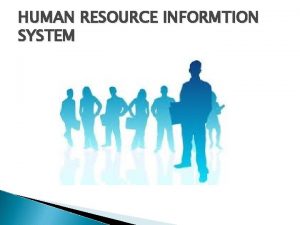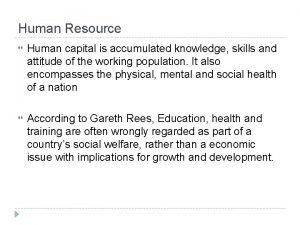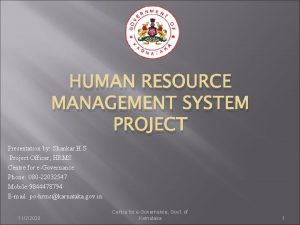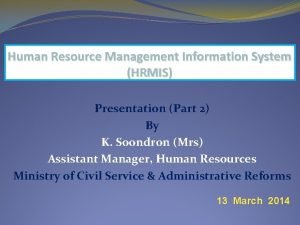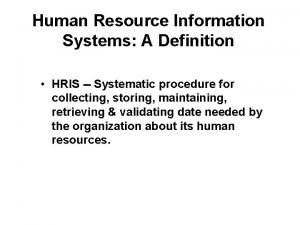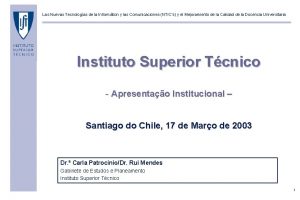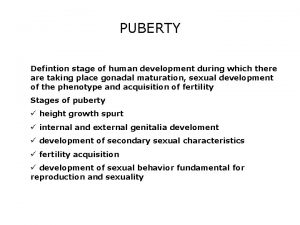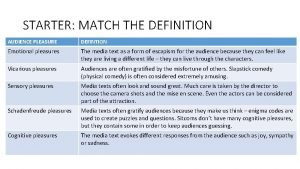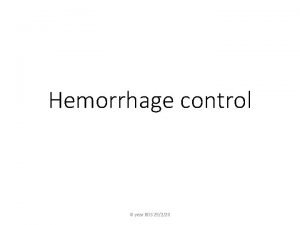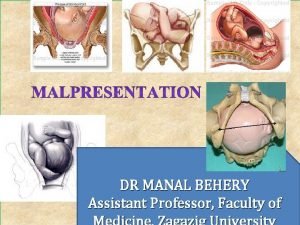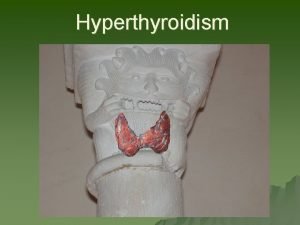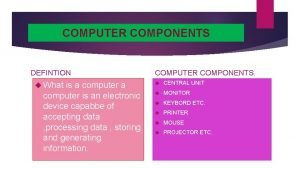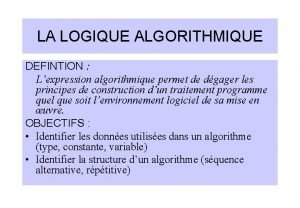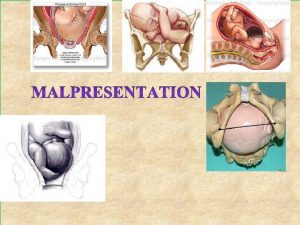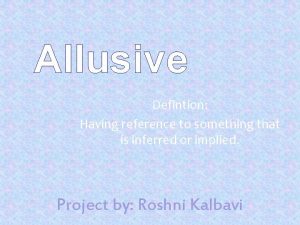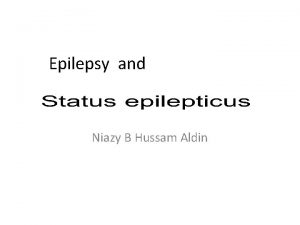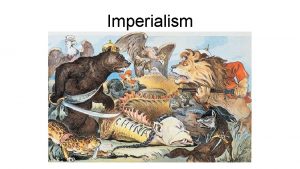HUMAN RESOURCE INFORMTION SYSTEM Defintion The Human Resource






























- Slides: 30

HUMAN RESOURCE INFORMTION SYSTEM

Defintion: The Human Resource Information System (HRIS) is a software or online solution for the data entry, data tracking, and data information needs of the Human Resources, payroll management, and accounting functions within a business.

CONCEPT OF HRIS Human Resource Information System is a system designed to supply information required for effective management of an organisation. Any organisation is managed by taking various decisions at its various decisions at the Various level of its management hierarchy is needed to take these decisions.

Data vs Information Data - “Just the facts” >>raw facts Information - data that has been transformed into a more useful or meaningful form 4

Data vs Information Finance Justin Communications Pujah Ty Zlotnick Psychology Shah Alge Richardson 5

Data vs Information Last. Name First. Name Major Favorite_Teacher Richardson Ty Psychology Alge Shah Pujah Finance Alge Communications Alge Zlotnick Justin 6

How does data become information? Data Transformation Process Information

What is a “System” A set of elements or components that are formed and interact to accomplish a goal (e. g. transform data into information) 8

What is an Information System? Input Processing Feedback Loop Output

An HR Example Input (hours worked) Processing (Calc. Net pay) Feedback Loop (Is paycheck accurate? ) Output (cut paycheck)

Evolution of Information Systems Transaction Processing (e. g payroll) Management Information Systems (e. g. daily & monthly absenteeism summary) Decision Support Systems (e. g. How many employees should we hire? ) Expert Systems 11

COMPUTERISED HUMAN RESOURCE INFORMATION SYSTEM o o A computerised HRIS is designed to monitor , control and influence the movement of people from the time they join the organisation till the time they separte from the organisation. HRIS is very vast and it include the following sub-systems: Recruitment sub-system information Manpower planning Sub-system Information Personnel Administration Sub-system Information Training Information Sub-system

o o o Maintenance Sub-system Information Appraisal Sub-system Information Payroll Sub-system Information Personnel Research Sub-system Information Job Analysis and Design Sub-system Information.

OBJECTIVES OF HRIS q To make the desired information available in the right form to the right person and at the right time. q To supply the desired information at a reasonable cost. q To use the most efficient method of processing data. q To provide necessary security and secrecy for important and/or confidential information. q To keep the information up-to-date.

FUNCTIONING OF HRIS It can be brodaly classified into two processes: 1. Data Collection-who should collect what data and in what form and how often? the nature and form of data will vary from organisation to organisation depending upon its objectives. After collection of data, the irrelevant data should be filtered out and the relevant data should be properly classified and tabulated so that it can be used easily when needed.

2. Data Management-It involves the following sub-system: Data Management-A goodd data management system involves editing the data. Processing Operations viz, classifying, , analysing , summarising and editing the data. Storage of data viz, indexing, coding and filing of information.

Retrieval of data, whenever required. Evaluation : i. e, judging the usefullness of information in terms of its relevance and accuracy. Dissemination i. e, providing the required data in the right form at the right time.

DESIGNING OF HRIS It consists of the following steps: 1. Planning of system-It requires the identification of objectives of the system. This further requires a clear formulation of objectives of the organisation, spelling out of the activities required to be carried out, work relationships, work patterns.

2. Organising Flow of Information-The system designer should study what is the prevailing flow of information and compare it with what should be flow of information. It based on following premises: The managers need the information he wants for decision making. Better communication between manager will improve organisational performance.

3. Implementation-This phase deals with the fitting in HRIS into the organisation structure. The varipous alternative available in this connection are: The old information flow may be allowed to continue as it ia ang new system may be installed to meet the requirement of the new operation.

The manager needs the information he wants for decision making. If a manager has the information he needs, , the decision-making will improve. Better communication between managers will improve organisational performance. A manager does not have to understood how his information system works, only how to use it.

The old system may be scrapped completely and supplanted by the new one. Phasing the installation of the new system and scrapping the old one. 4. Feedback-The regular feedback regarding the actual functioning of the HRIS is a must for the designers to fill up the gap between its planning and implementation. Hence the system should be continously reviewed in the light of changes in the environment both within the organisation and outside the organisation.

APPLICATIONS OF COMPUTERISED HRIS 1. Job Description-Produce printouts that describes jobs according to user specifications and information input into the system. As a minimum job description includes job title, purpose, duties and responsibilities, the computer program should allow the authorised users to update and reformat job descriptions.

2. HR Planning-Forecast demands for key jobs as well as employees turnover and patterns of inter-organisational mobility. 3. Staffing-Address recruitment, selection and placement functions and can include thefollowing modules: Applicant tracking Job posting Job requirements analysis

Job person matching 4. Succession Planning-Report information on the avalaibility if competent candidates for key positions. It can help in identifying candidates for each key positions and the development needs of candidates where they fall short of the requirements for a target job. 5. Training and Development-It includes the following:

Career planning. Development needs analysis. Development advisor. 6. Performance Appraisal-Help managers direct employees to achieve organisational goals and develop their competencies. It includes the following: Performance assessments

Goals accomplishments Reward management 7. Job Evaluation-Computer assisted job evaluation system helps managers determine job evaluation points or classification levels and job hierarchies. 8. Compensation-Track, analyse and report compensation information on pay grade structures, merit guidelines, support salarybudgeting.

Why HRISs Sometimes Fail Unclear goals/objectives System solves the wrong problem Improper vendor/product selection Low user involvement Planning overlooks impact on clerical procedures Lack of HR/functional expertise in designing Underestimate conversion effort n n n Management- unrealistic expectations Lack of overall plan for record mgt. Lack of flexibility and adaptability Misinterpret HR specifications Poor communication between HR/IS Inadequate testing 28

Why are Carefully Developed Info Systems Important to HR? Better safety Better service Competitive Advantage Fewer Errors Greater Accuracy Higher Quality Products Improved Health Care Improved Communication Increased Efficiency n n n n Increased Productivity More efficient administration More opportunities Reduced labor requirements Reduced costs Superior managerial decision making Superior control 29

 Informtion system
Informtion system Decruitment meaning
Decruitment meaning Human capital defintion
Human capital defintion Management is universal and everywhere
Management is universal and everywhere Hrms shanker group
Hrms shanker group Human resource management information system (hrmis)
Human resource management information system (hrmis) Define hris system
Define hris system Resource leveling is the approach to even out the peaks of
Resource leveling is the approach to even out the peaks of Perbedaan resource loading dan resource leveling
Perbedaan resource loading dan resource leveling Hát kết hợp bộ gõ cơ thể
Hát kết hợp bộ gõ cơ thể Lp html
Lp html Bổ thể
Bổ thể Tỉ lệ cơ thể trẻ em
Tỉ lệ cơ thể trẻ em Gấu đi như thế nào
Gấu đi như thế nào Tư thế worms-breton
Tư thế worms-breton Bài hát chúa yêu trần thế alleluia
Bài hát chúa yêu trần thế alleluia Môn thể thao bắt đầu bằng chữ đua
Môn thể thao bắt đầu bằng chữ đua Thế nào là hệ số cao nhất
Thế nào là hệ số cao nhất Các châu lục và đại dương trên thế giới
Các châu lục và đại dương trên thế giới Công thức tính độ biến thiên đông lượng
Công thức tính độ biến thiên đông lượng Trời xanh đây là của chúng ta thể thơ
Trời xanh đây là của chúng ta thể thơ Mật thư tọa độ 5x5
Mật thư tọa độ 5x5 Làm thế nào để 102-1=99
Làm thế nào để 102-1=99 Phản ứng thế ankan
Phản ứng thế ankan Các châu lục và đại dương trên thế giới
Các châu lục và đại dương trên thế giới Thơ thất ngôn tứ tuyệt đường luật
Thơ thất ngôn tứ tuyệt đường luật Quá trình desamine hóa có thể tạo ra
Quá trình desamine hóa có thể tạo ra Một số thể thơ truyền thống
Một số thể thơ truyền thống Cái miệng nó xinh thế
Cái miệng nó xinh thế Vẽ hình chiếu vuông góc của vật thể sau
Vẽ hình chiếu vuông góc của vật thể sau Thế nào là sự mỏi cơ
Thế nào là sự mỏi cơ
